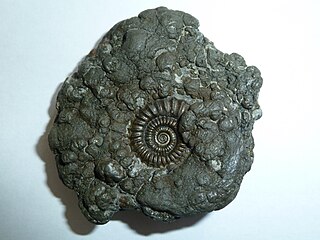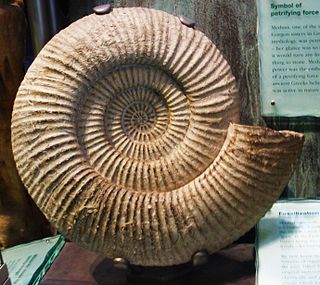Abbasites is an extinct genus of ammonites from the early Middle Jurassic epoch, included in the ammonitid family Erycitidae.
Aegoceras is an evolutionary wound ammonite, with wide spaced ribs, from the Early Jurassic (England) included in the Liparoceratidae and superfamily Eoderoceratidae. Related genera are Leparoceras and Beaniceras.

Ancyloceras is an extinct genus of heteromorph ammonites found throughout the world during the Lower Cretaceous, from the Lower Barremian epoch until the genus extinction during the Lower Aptian.
Axonoceras is a genus in the ammonitid family Nostoceratidae proposed by Stephenson in 1941, for "slender shells coiled in a plane with numerous closely spaced ribs and two rows of ventral nodes'...The shells may be closely coiled, though not involute, but most... are more or less loosely and irregularly coiled". Shells may be coplanar or coiled in a low flat spiral with the early whorls in contact, later whorls free.
Frogdenites is an extinct ammonite genus from the order Ammonitida that lived during the Middle Jurassic in what is now Europe, Canada, and Tibet. Frogdenites is included in the Otoitidae, a family which makes up part of the ammonitid superfamily, Stephanoceratoidea.
Docidoceras is an extinct ammonite genus from the order Ammonitida that lived during the Middle Jurassic. Docidoceras is included in the family Otoitidae which makes up part of the ammonite superfamily Stephanoceratoidea.
Zemistephanus is an extinct ammonite genus from the middle Jurassic of western North America and Western Australia, named by McLearn 1927. Zemistephanus is included in the sephanoceratoid family Otoitidae, which are characterized by shells that begin as barrel-shaped cadicones but which become planulate later in life. Body chambers are reduced in size and are excentric. Similar genera are Pseudotoites and Emileia
Anisoceratidae is an extinct family of heteromorph ammonites which belong to the Ancyloceratina superfamily Turrilitoidea. Members of the family range is from the lower Albian to the upper Turonian. The family is possibly derived from a member of the Hamitidae.
Euaptetoceras is an evolute hildoceratoid ammonite from the lower Middle Jurassic, included in the family Hammatoceratidae and the subfamility Hammatoceratinae. The genus may be a junior synonym for Eudmetoceras of Buckman, 1920.
Ermoceras is a genus of ammonite belonging to the Thomboceratidae family of the Middle Jurassic found in deposites of central Arabia, Sinai, and Algeria with strong primary and secondary ribs and a single row of lateral tubercles; described as having a deep ventral groove

Durotrigensia is a genus of ammonites (Ammonitida) in the perisphinctoid family Parkinsoniidae.
Otoites is the type genus of the ammonite family Otoitidae that live during the Middle Jurassic.
Okribites is a perisphinctoidean ammonite from the middle Jurassic of the Republic of Georgia. It is assigned to the family Parkinsoniidae, a group of strongly but evenly ribbed evolute, commonly discoidal ammonites. Parkinsonia is a related genus.

Promicroceras is an extinct ammonite genus from the upper Sinemurian of Europe, named by Leonard Spath in 1925. Promicroceras is included in the family Eoderoceratidae, which is part of the ammonitid superfamily Eoderoceratoidea.

Psiloceras is an extinct genus of ammonite. Psiloceras is among the earliest known Jurassic ammonites, and the appearance of the earliest Psiloceras species form the definition for the base of the Jurassic. Unlike most earlier ammonites, which had complex shell shapes and ornamentation, Psiloceras had a smooth shell.
Otoidtidae: stephanoceratoid ammonitina from the early Middle Jurassic that begin as cadicones but become more planualte with age; derived from the Hammitoceratidae (Hildoceratoidea), probably through Erycites by way of Abbasites.

Titanites is an extinct ammonite cephalopod genus within the family Dorsoplanitidae, that lived during the late Tithonian of the Late Jurassic.

Rhacophyllites is an extinct genus of cephalopods belonging to the family Discophyllitidae. These nektonic carnivores lived during the Triassic period, from Carnian to Rhaetian age.

Dufrenoyia is an extinct genus of Cretaceous ammonites included in the family Parahoplitidae. These fast-moving nektonic carnivores lived in the Cretaceous period. The type species of the genus is Ammonites dufrenoyi.
Trachyceras is a genus belonging to the extinct subclass of cephalopods known as ammonites. Specifically it belongs in the order Ceratitida. They are distributed in Afghanistan, Bosnia and Herzegovina, Canada, China, Germany, Hungary, India, Indonesia, Italy, the Russian Federation, Slovenia, United States.






